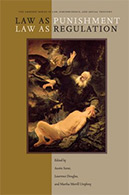Law as Punishment / Law as Regulation
 Austin Sarat, Lawrence Douglas and Martha Merrill Umphrey, editors
Austin Sarat, Lawrence Douglas and Martha Merrill Umphrey, editors
Stanford, CA: Stanford University Press, 2011. 185 p.
Reviewer: Ana Aliverti | May 2012
This book is a collection of essays examining the relationship between regulation and punishment from different perspectives. They have been previously presented in a series of seminars at Amherst College, Massachusetts, United States, between 2008 and 2009. The papers by North American-based scholars look at the core theme of the book from legal theory, political science, socio-legal studies and criminal law theory perspectives. Contributions are duly US-centred –with the exceptions of Dubber and Brettschneider- focusing upon US legislation, jurisprudence and institutions. This book builds on the literature about the destabilisation of the criminal and civil divide and more specifically on so-called ‘civil sanctions.’ More broadly, it fits in the body of work exploring the changing role of criminal punishment and the criminal justice system in contemporary societies, following Simon and Feeley‘s work on the ‘new penology’ and John Braithwaite’s on the ‘new regulatory state.’ Broadly situated within the Foucaultian tradition, the articles in this collection consider the distinction between regulatory and punitive regimes; the intertwining of punishment and regulation in particular measures; whether there is any difference between punishment and regulation and if there is a value in maintaining such classification; and the political and moral justification of state coercion -be it in the form of punishment or/and of regulation.
Austin Sarat, Lawrence Douglas and Martha Merrill Umphrey open the book by describing the paradigmatic case of the Megan’s law-type register for convicted sex offenders, enacted in many states in the US. The introduction to the book inquires whether Megan’s law-type measures are punitive or regulatory in nature. The authors explain that the decision on whether a particular coercive measure is considered punishment or regulation is not merely a classificatory exercise without any practical consequences. Rather, it has important repercussions on the procedural and substantive protections for those subject to them. In analysing the distinction between regulation and punishment, the authors dissect the criteria developed by the US Supreme Court in Artway v. The Attorney General of the State of New Jersey, the legal challenge to New Jersey’s Megan’s Law. They critically assess this categorisation, suggesting that it is ultimately futile: ‘[the Supreme Court] insists on an absolute distinction between punishment and regulation instead of attempting to understand regulation and punishment in relational terms, with regulation the more inclusive concept’ (p 4). Following Foucault, they understand regulation (and discipline) as permeating and penetrating punishment. They also criticise the Court’s criteria because it is focused on the labelling done by those who authorise or enforce state coercion, thus neglecting the perspective of those who suffer it. Instead, Sarat et al consider the perception of the ‘victim’ or the ‘recipient’ about the regulatory or punitive nature of a given form of state power –such as detention- to be crucial in this classificatory exercise.
The idea of punishment as subsumed by that of regulation is contested head-on by Markus Dubber. Drawing on the concept of ‘police power,’ Dubber asserts that the distinction between punishment and regulation should be reconceptualised by focusing instead on the discussion of the law vis-à-vis the police. While they are different, he claims that they are two aspects of the scope and limits of state power. Dubber finds the historical origins of the police power in the prerogatives of the householder over the members of his household. As opposed to the concept of law which is based on the equality of rights and it is relatively more modern, the police power is premised on the supremacy of the master or householder over his subjects, and dates back to ancient Greece. Because the former is in charge of the wellbeing of the members of the household and its smooth running, his powers are limitless. Thus, the master is bestowed with wide, unconstrained discretionary and disciplinary powers. The police power has not disappeared, Dubber argues, but is entrenched in contemporary modes of governance. The contrast between police and law –or between regulation and punishment- is illustrated by the difference in the criminal law realm between penal law and penal regulation. While ‘paradigmatic’ criminal law treats people as autonomous and rational beings, criminal regulation (epitomised by so-called regulatory offences) considers them as resources to be managed. Through his tireless attempts to distance himself from his fellow ‘regulatory’ scholars, Dubber draws a clear difference between law and regulation as distinct but parallel modes of governance.
Corey Brettschneider’s paper explores the contributions of Jean-Jacques Rousseau’s social contract to the political justification of punishment and, in particular, to the political legitimacy of state punishment. She argues that Rousseau places two fundamental limits to the state’s power to punish: first, through the ‘ideal of hypothetical consent,’ it subjects legislation and coercive measures to the ‘hypothetical consideration’ of individuals: ‘This hypothetical consideration of what individuals would say about any policy […] is a way of considering the distinct interests of all citizens’ (p 56). Second, the state loses its legitimate authority to carry out punishments when it fails to guarantee a decent level of social welfare for its citizens. The author claims that Rousseau’s thesis places robust limits on when and how the state can punish. Still, she only refers to the case of capital punishment to explain how the social contract thesis may restrict the state’s punitive prerogatives. More importantly, even though Brettschneider recognises that the idea of ‘hypothetical consent’ is problematic, she insists on the fiction of the social contract to justify the consensual basis of social institutions, particularly punishment. The artificiality of the social contract –and the problems of using such construction to justify state coercion- become more acute in contemporary societies where citizenship is no longer a fundamental category to draw the boundaries of membership.
The book turns once again to its core theme in Alec Ewald’s paper on collateral consequences of punishment. He describes the myriad of ‘collateral sanctions’ which are legally separate from a criminal conviction but are often attached to it, such as deportation and restrictions on the right to work, to serve on a jury, to vote, to live in public housing, etc. He explains that ‘collateral sanctions expand the penal institution in both place and time –beyond the prison walls […] and beyond the sentence as well’ (p 78). These ‘sanctions’ remain in a grey legal area because they are not considered ‘punishment,’ being labelled as regulatory even though they have long-term punitive effects. Ewald powerfully argues that such sanctions restrict fundamental rights which formed the core of US citizenship and thus, have the effect of turning convicted offenders in second class citizens. Not only do collateral consequences of punishment restrict the rights of ex-offenders directly. They have other indirect effects: for instance, employers regularly carry out criminal background checks over prospective employees, as do private landlords with potential tenants. Courts generally consider that these sanctions are regulatory and preventive, rather than punitive. In this respect, Ewald notes a contradiction between the expressive, punitive functions that these sanctions are called to perform, and their actual effect. Because they are not considered part of the criminal law, they remain ‘invisible,’ and are generally imposed by non-penal institutions, they fail to fulfil this expressive function. He contends that because of their murky status, in-between regulation and punishment, they are ineffective and counterproductive.
Susanna Lee looks at the relationship between punishment and regulation in the novel Clockers by Richard Price. In particular, she analyses different forms of regulation, both before punishment and after it. In the former, regulation works to avoid punishment. Punishment ‘precedes disobedience and so acts itself as an instrument of regulation’ (p 125). Thus, regulation is the imposition of rules which, when followed, dispense one from punishment and, in its ex post facto version, regulation is itself punishment. Then, regulation is understood by Lee as comprising punishment. Punishment, in her thesis, does not need to be imposed to exert regulatory functions. By exploring these two forms of regulation through a work of fiction, Lee shows how regulation largely depends on self-regulation by, first, making the regulated subjects conscious about them being unregulated and thus punishable, and, second, by imputing on them the responsibility for self-regulation.
The book closes with Paul Butler’s article on ‘stop and frisk.’ Relying on Foucault’s description of the use of torture during the Ancient Regime, Butler argues that ‘stops and frisks’ can be ‘constructed’ as a form of torture because these measures produce similar ‘injuries’ and have the same kind of ‘benefits’ as those of torture (p 155). He further claims that stops and frisks blur the line between regulation and punishment as they constitute punishment imposed for regulatory purposes. He explains: ‘Police stops and frisks demonstrate the authority of the state in the most visceral way. They signal that the police control the streets, and they signal this in a way that is public, spectacular, corporal, and punitive’ (p 169). ‘Stop and frisk’ measures have been upheld by the US Supreme Court in Terry v. Ohio, in which the Court authorised the police to briefly detain a person when the officer has ‘reasonable suspicion’ that a crime may be occurring or is about to be committed. The police are also authorised to pat down the individual whom they had stopped if they have reasonable suspicion that the person is carrying a gun. In doing so, the Court required a lower standard than that of ‘probable cause’ specified in the US Constitution for seizures and searches. Butler discusses extensively the damaging effects of these measures on ‘victims.’ People stopped and frisked, he explains, usually perceive such intrusion as abusive and analogous to sexual assault or harassment. While Butler’s thesis is provocative, he does not clarify whether it is the arbitrary exercise of stop and frisk which makes it constitutionally questionable or it is unconstitutional per se. Further, he falls short of explaining the analytical or legal value of equating it to forms of torture.
This book constitutes an important contribution to the recent academic debate on punishment and regulation, particularly among criminal law and criminology scholars. One of the main conclusions that can be drawn from this book is that the line dividing punishment and regulation, the punitive or regulatory nature behind a certain measure, is neither clear and neat, nor uncontroversial. While the introduction of a myriad of measures which sit between civil and penal sanctions in recent years has contributed to making this distinction more problematic, as Dubber shows, the hybridity of penality is much older. More fundamentally, the difficult task of embarking on such categorisation has a number of consequences, as Sarat et al and Ewald suggest. The role of academics is therefore to recognise that they are both sides of a same coin and to develop principles that fit such a construction.
Ana Aliverti is a DPhil candidate in the Centre for Criminology, University of Oxford


